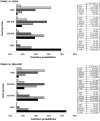HIV-1 disease progression during highly active antiretroviral therapy: an application using population-level data in British Columbia: 1996-2011
- PMID: 24135777
- PMCID: PMC3800281
- DOI: 10.1097/QAI.0b013e3182976891
HIV-1 disease progression during highly active antiretroviral therapy: an application using population-level data in British Columbia: 1996-2011
Abstract
Background: Accurately estimating rates of disease progression is of central importance in developing mathematical models used to project outcomes and guide resource allocation decisions. Our objective was to specify a multivariate regression model to estimate changes in disease progression among individuals on highly active antiretroviral treatment in British Columbia, Canada, 1996-2011.
Methods: We used population-level data on disease progression and antiretroviral treatment utilization from the BC HIV Drug Treatment Program. Disease progression was captured using longitudinal CD4 and plasma viral load testing data, linked with data on antiretroviral treatment. The study outcome was categorized into (CD4 count ≥ 500, 500-350, 350-200, <200 cells/mm, and mortality). A 5-state continuous-time Markov model was used to estimate covariate-specific probabilities of CD4 progression, focusing on temporal changes during the study period.
Results: A total of 210,083 CD4 measurements among 7421 individuals with HIV/AIDS were included in the study. Results of the multivariate model suggested that current highly active antiretroviral treatment at baseline, lower baseline CD4 (<200 cells/mm), and extended durations of elevated plasma viral load were each associated with accelerated progression. Immunological improvement was accelerated significantly from 2004 onward, with 23% and 46% increases in the probability of CD4 improvement from the fourth CD4 stratum (CD4 < 200) in 2004-2008 and 2008-2011, respectively.
Conclusion: Our results demonstrate the impact of innovations in antiretroviral treatment and treatment delivery at the population level. These results can be used to estimate a transition probability matrix flexible to changes in the observed mix of clients in different clinical stages and treatment regimens over time.
Conflict of interest statement
Conflicts: Dr. Julio Montaner has received grants from Abbott, Biolytical, Boehringer Ingelheim, Bristol-Myers Squibb, Gilead Sciences, Janssen, Merck and ViiV Healthcare. He is also is supported by the Ministry of Health Services and the Ministry of Healthy Living and Sport, from the Province of British Columbia; through a Knowledge Translation Award from the Canadian Institutes of Health Research (CIHR); and through an Avant-Garde Award (No. 1DP1DA026182) from the National Institute of Drug Abuse, at the US National Institutes of Health. He has also received support from the International AIDS Society, United Nations AIDS Program, World Health Organization, National Institute on Drug Abuse, National Institutes of Health Research-Office of AIDS Research, National Institute of Allergy & Infectious Diseases, The United States President’s Emergency Plan for AIDS Relief (PEPfAR), Bill & Melinda Gates Foundation, French National Agency for Research on AIDS & Viral Hepatitis (ANRS), Public Health Agency of Canada
Figures
References
-
- Mellors JW, Munoz A, Giorgi JV, et al. Plasma viral load and CD4+ lymphocytes as prognostic markers of HIV-1 infection. Ann Intern Med. 1997;126:946–954. - PubMed
-
- Moss AR, Bacchetti P. Natural history of HIV infection. AIDS. 1989;3(2):55–61. - PubMed
-
- Carpenter CJC, Fischl MA, Hammer SM, et al. Antiretroviral Therapy for HIV Infection in 1996. JAMA. 1996;276 (2):146–154. - PubMed
-
- Thompson MA, Aberg JA, Hoy JF, et al. Antiretroviral treatment of adult HIV infection: 2012 recommendations of the International Antiviral Society-USA panel. JAMA. 2012;308(4):387–402. - PubMed
Publication types
MeSH terms
Substances
Grants and funding
LinkOut - more resources
Full Text Sources
Other Literature Sources
Medical
Research Materials



